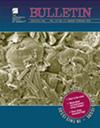The formation of a giant post-collision porphyry copper system: A case study of the Jiama deposit, Tibet
IF 3.9
1区 地球科学
Q1 GEOSCIENCES, MULTIDISCIPLINARY
引用次数: 0
Abstract
The large magma reservoirs underlying world-class porphyry deposits are one of the key factors in their formation, which thus led to the present study focusing on the unmineralized intrusive rocks underlying the porphyry molybdenum-copper orebody of the post-collisional Jiama porphyry-skarn copper-polymetallic deposit in southern Tibet. The Jiama porphyry intrusion comprises intermediate-silica quartz diorite, monzogranite, and granodiorite porphyries, as well a high-silica granite porphyry. The intrusive rocks suite exhibits similar whole-rock Sr-Nd isotopic compositions [εNd(t) = −3.9 to −0.8], suggesting a common, non-radiogenic magma source. Yet, these rocks have distinct geochemical characteristics. The intermediate-silica rocks are relatively enriched in Ba and Sr with minor Eu anomalies, and show adakite-like geochemical characteristics. In contrast, the high-silica granite porphyry is strongly depleted in Ba, Sr, and Eu, and lacks adakite-like geochemical characteristics. We propose that the high-silica granite porphyry represents highly fractionated melt extracted from a silicic mush reservoir (crystallinity of ∼40%−65%), and that the monzogranite and granodiorite porphyries constitute the complementary residual silicic cumulates. High crystallinity facilitates the formation of connected fluid pathways, allowing the efficient removal of volatiles from the remaining silicic melt and a rapid flux of the ore-forming fluids toward the apical parts of the large magma reservoir. Less-evolved mafic melt is believed to have repeatedly intruded the base of the magma reservoir, thereby releasing volatiles and water into the silicic mush systems. The volatiles migrated upward through the fluid channels and accumulated in the apical part of the magma reservoir, subsequently, as a result of the overpressure in the roof zone, ore-forming fluids and successive batches of magma were expelled together, thereby forming the Jiama porphyry-skarn deposit.巨型碰撞后斑岩铜系的形成——以西藏嘉玛矿床为例
世界级斑岩矿床下伏的大型岩浆储层是其形成的关键因素之一,因此本研究的重点是藏南后碰撞佳马斑岩矽卡岩铜多金属矿床斑岩钼铜矿体下伏的未矿化侵入岩。佳马斑岩侵入体由中硅石英闪长岩、二长花岗岩、花岗闪长斑岩和高硅花岗斑岩组成。侵入岩套显示出相似的全岩Sr-Nd同位素组成[εNd(t)=−3.9至−0.8],表明其为常见的非放射性岩浆源。然而,这些岩石具有明显的地球化学特征。中硅石中Ba、Sr相对富集,Eu异常较小,具有埃达克岩状地球化学特征。相比之下,高硅花岗斑岩的Ba、Sr和Eu含量严重贫化,缺乏埃达克岩状的地球化学特征。我们提出,高硅花岗斑岩代表从硅化物糊状储层中提取的高度分馏熔体(结晶度为~40%−65%),二长花岗岩和花岗闪长岩斑岩构成互补的残余硅化物堆积体。高结晶度有助于形成连通的流体通道,从而有效地去除剩余硅化物熔体中的挥发物,并使成矿流体快速流向大型岩浆储层的顶部。据信,进化程度较低的镁铁质熔体多次侵入岩浆库底部,从而将挥发物和水释放到硅化物糊状物系统中。挥发物通过流体通道向上迁移,并在岩浆库的顶部积累,随后,由于顶板带的超压,成矿流体和连续批次的岩浆一起排出,从而形成了佳马斑岩矽卡岩矿床。
本文章由计算机程序翻译,如有差异,请以英文原文为准。
求助全文
约1分钟内获得全文
求助全文
来源期刊

Geological Society of America Bulletin
地学-地球科学综合
CiteScore
9.30
自引率
8.20%
发文量
159
审稿时长
4-8 weeks
期刊介绍:
The GSA Bulletin is the Society''s premier scholarly journal, published continuously since 1890. Its first editor was William John (WJ) McGee, who was responsible for establishing much of its original style and format. Fully refereed, each bimonthly issue includes 16-20 papers focusing on the most definitive, timely, and classic-style research in all earth-science disciplines. The Bulletin welcomes most contributions that are data-rich, mature studies of broad interest (i.e., of interest to more than one sub-discipline of earth science) and of lasting, archival quality. These include (but are not limited to) studies related to tectonics, structural geology, geochemistry, geophysics, hydrogeology, marine geology, paleoclimatology, planetary geology, quaternary geology/geomorphology, sedimentary geology, stratigraphy, and volcanology. The journal is committed to further developing both the scope of its content and its international profile so that it publishes the most current earth science research that will be of wide interest to geoscientists.
 求助内容:
求助内容: 应助结果提醒方式:
应助结果提醒方式:


